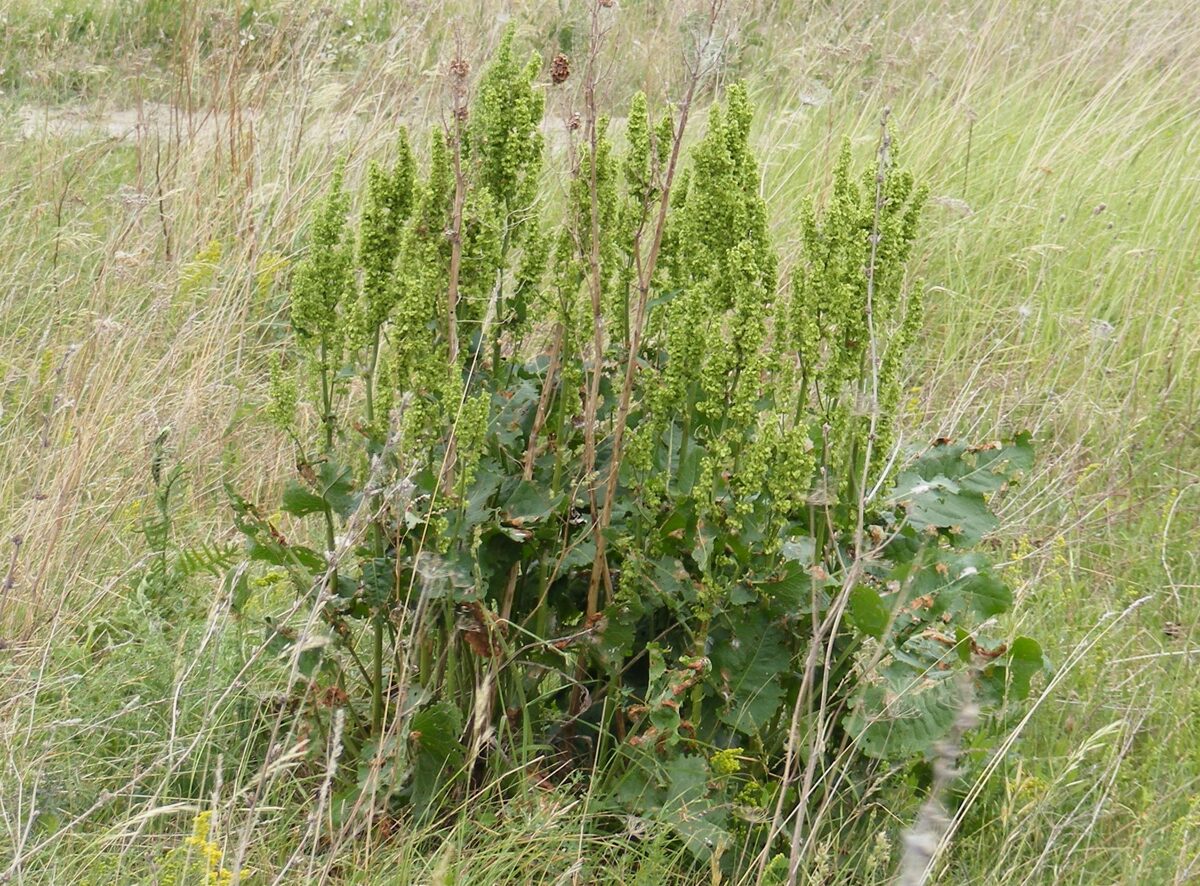 |  |  |    |  |
 |  |
A large, perennial plant with a thick taproot. Characteristic pale green, grayish oval-triangular rhizome leaves with a faint heart-shaped base, up to 20cm long and 10cm wide. Hairy leaves are also characteristic (on the underside of the leaf, the veins are short but densely hairy). The flowers are small, actinomorphic (correct) green, bisexual, arranged in a dense pyramidal raceme. The fruit is a three-sided nut. Blooms in May-June. The seeds ripen from July to November.
Rhizomes and roots of Russian Dock are used for medicinal purposes. The organs of the underground plant are collected in autumn, until the above-ground part of the plant has died. Or in the spring, until the vegetation starts (April-May). The rhizomes and roots are cleaned from the soil, the surface part is separated, rinsed in cold water. It is allowed to wind in the sun, then chop, cut the thick rhizomes lengthwise and dry in well-ventilated and shady places. Do not exceed 45C in forced fascinators.
Russian Dock contains a lot of biologically active substances, so it is also used in medicine. The main biologically active substances are anthraquinones (<4.1%), which are present in free form as glycosides. Anthraquinones in Russian Dock are present in a related form - oxymethylanthraquinones, as glycosides: chrysophanein, glycofrangulaemodin, rheochrysin, glycoaloe-emodin and glycorein. Along with anthracene derivatives, the plant also contains tannins, which are polymers of catechins (<16% in rhizomes and fruits). Flavonoids are also found in the rhizomes: flavones (quercetin and glycosides - hyperoside, rutin and bioside of quercetin flavones - rumarin) and leucoanthocyanidins (leucoanthocyanidin, leucodelphinin, leucopelargonidin). The rhizomes and roots also contain phenol carbonate acids (caffeic acid and chlorogenic acid), citric and lactic acid, traces of essential oils, oxycoumarins, iridoids, steroids, resins, up to 1,
The surface part of the plant is also valuable and rich in biologically active substances. Leaves contain anthracene glycosides (<0.43%), flavonoids (hyperin <1.48%, rutin), tannins (2-7%), ascorbic acid (183.9 mg), carotene (8mg), oxycinnamic acid (< 3.31%).
Russian Dock flowers contain 2.5% essential oil, 2.5% rutin, quercetin, cyanide-3-glucoside, ascorbic acid. Tannins are found in the fruit, mainly pyrocatechin and pyrogal groups (including glycogallin), as well as flavonoids (quercetin, rutin), and ascorbic acid.
Tannins (<7.36%) and ascorbic acid (<200mg%) accumulate maximally in unripe fruits, while flavonoids (<1.6%) and resins (<3.5%) in ripe fruits.
Acids have the ability to accumulate oxalic acid and its salts, basically potassium oxalic acid, in all their organs. The most oxalic acids and oxalates are found in roots and rhizomes (<12.95%), while free acids are in the above-ground part of the plant, especially in the leaves.Medicinal significance
Russian Dock preparations have a firming and astringent effect. It binds to tannins (tannins) present in the plant, which cause protein coagulation, which stimulates the formation of a protective layer on the intestinal walls. It contributes to the reduction of secretory activity, suppression of transudation processes, protection of intestinal walls against irritation.
A similar effect can be observed when using Russian Dock preparations, also in case of burns and ulcers.
Preparations of the rhizomes and roots of the Russian Dock have a laxative effect in large doses due to the anthraquinone compounds present in the plant. Anthraquinones stimulate the peristalsis of the muscles of the large intestine, and contribute to the liquefaction of fecal masses. The laxative effect appears only after 8-12 hours, so for this purpose the plant is used at night.
The complex of biologically active substances in the plant ensures its effect as a choleretic agent, antioxidant and has hepaprotector properties. The hepatoprotective effect is provided by the antioxidant and membrane-stabilizing properties of leukoanthocyanidins and catechins. In addition, leucoanthocyanidins and catechins also produce antitumor activity.
Infusions, decoctions and extracts are used to treat colitis and enterocolitis, as a mild laxative, in case of intestinal atony. It is also used to facilitate faecal output in case of hemorrhoids and anal hernias.
Acids are also used as a remedy for helminths and in case of salmonellosis, in children. Russian Dock extract is used as an anti-ringing remedy and for prevention, to treat hypo- and avitaminosis C, as well as to stimulate bile production and bile output function in the liver, in case of hepatitis, cholecystitis and cholangitis. However, the therapeutic effect of galena monotherapy with galena preparations is weak, therefore it is preferable to use Russian Dock together with other herbs, as a mixture of ingredients.
A decoction of the roots of Russian Dock works perfectly in the treatment of alcohol withdrawal syndrome. In the first hours after using Russian Dock , the patient's condition and well-being improves, headache decreases, arterial pressure decreases, tachycardia, thirst, nausea, dyspeptic phenomena disappear, appetite begins to appear and sleep improves!
In Brazilian folk medicine, a decoction of the roots of Russian Dock is used externally to relieve enlarged lymph nodes and taken orally as an anti-scurvy, purgative, antipyretic and tonic. In India, root juice is used to relieve toothache, but root powder is used for inflammation of the gums; used as toothpaste. In Thailand, this plant is used in steam baths to soothe the eyes and treat ulcers. With the juice of the roots of Russian Dock , Tibetan medicine recommends treating skin diseases.
In the folk medicine of Central Asia and Tajikistan, the juice of Russian Dock leaves is recommended for use in case of nausea, heartburn and jaundice, as well as gargling with it in case of angina and bleeding gums.
A decoction of dried fruits is used to treat gastritis and stomach ulcers. On the other hand, a decoction of roasted fruits is used to treat colitis, enterocolitis and dysentery. Russian Dock leaves smeared with melted butter are applied to wounds, abscesses and boils.
Children suffering from skin diseases and rashes are bathed in infusions of flowers.
In Slovak folk medicine, a decoction of the root is used as a blood-stopping agent, for the treatment of lungs, uterus, stomach, intestines and hemorrhoids.
